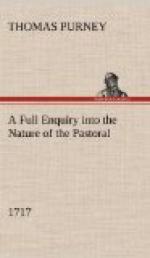In his usual nervous manner, the critic did not confine himself to his topic, but touched on a number of significant peripheral subjects. He showed the virtue of concrete and specific imagery at a time when most poets sought the sanctuary of abstractions and universals; commented cogently on the styles of Chaucer, Spenser, and Shakespeare; anticipated the later doctrine of the power of the incomplete and the obscure to suggest and therefore to compel the imagination to create; adopted and expanded Addison’s distinction between the sublime and the beautiful; and, borrowing a suggestion that he probably found in Dennis (Critical Works, ed. Edward N. Hooker, Baltimore, 1919, I, 47), developed a profitable distinction between the sublime image and the sublime thought by examining their different psychological effects.
But, because they run counter to the accepted opinions of his age, it is Purney’s comments on matters of style that are especially striking, although it must be remembered that most of them have to do with the pastoral alone and do not constitute a general theory of poetics. Perhaps his most original contribution is his attack upon the cautious contemporary styles of poetry: “strong lines,” a term that originally defined the style of the metaphysical poets, but that now described the compact and pregnant manner of Dryden’s satires, for example, and the “fine and agreeable,” exemplified, let us say, by Pope’s Pastorals or Prior’s vers de societe. To these Purney preferred the bolder though less popular styles, the sublime and the tender, corresponding to the two pure artistic manners that Addison had distinguished. How widely Purney intended to diverge from current poetry can be judged by his definition of the sublime image as one that puts the mind “upon the Stretch” as in Lady Macbeth’s apostrophe to night; and by his praise of the simplicity of Desdemona’s “Mine eyes do itch.” Both passages were usually ridiculed by Purney’s contemporaries as indecorous.




